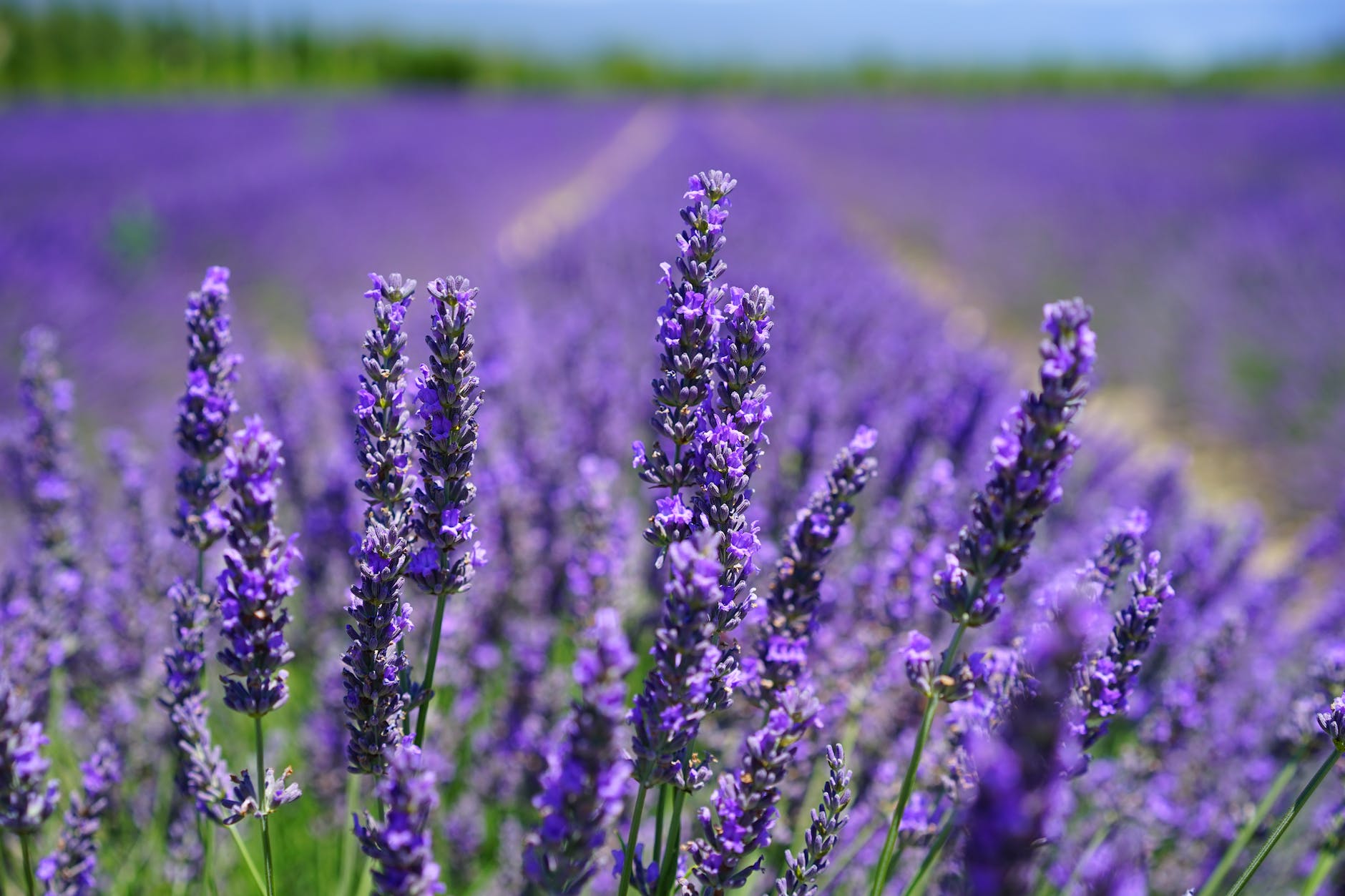What Does Lavender Smell Like?
Lavender, that small purple bud with a big punch of fragrance, what exactly does it smell like? Well, it’s an amalgamation of sweet, floral notes with a hint of herbaceous and woody undertones.
Quite exquisite in its complexity! The scent is rich yet gentle, rubbing on the senses like silk.
It’s an experience that transports you to the serene lavender fields in Provence without any airfare. The beauty of lavender’s scent is that it can be quite subjective.
Some might find it vividly sweet and floral; others will pick up more on the green freshness or subtly resinous undertone. The way our olfactory sense perceives the lavender scent can be influenced by multiple factors – our genetic makeup, personal experiences, even how often we’ve been exposed to similar smells.
However you perceive it though, there’s no denying its unique appeal. Originating from the mint family, Lavandula (or as we know it – Lavender), didn’t just pop up overnight with its signature scent.
It was years and years of evolutionary processes that granted this plant its distinctive aroma. But why does lavender smell like this?
What’s behind these layers of fragrance that awaken your senses? When we talk about the science behind this fragrance phenomenon – beyond being simply ‘pleasant’ to humans – most botanical experts agree that these aromatic compounds evolved primarily as a defense mechanism for plants against pests and diseases.
But there is more than just survival at stake here… One theory suggests that pollinators such as bees are attracted to flowers with strong scents like lavender because they associate them with ample nectar supplies. So ultimately, what seems merely delightful to us serves a crucial role in ensuring the survival and proliferation of these species!
What Is Lavender?
Lavender, my dear reader, is a fragrant flowering plant that belongs to the mint family. Its scientific name, Lavandula, hails from the Latin ‘lavare’, meaning ‘to wash’, hinting at its historical use in baths and laundry. It’s a versatile and hardy perennial that grows in myriad conditions across the globe.
The plant gives off an unmistakable lavender scent that has been cherished by people throughout history. The lavender plant has an interesting structure with long stems reaching up toward the sky, often reaching heights between one and two feet.
Each stem is adorned with a beautiful arrangement of tiny flowers in tones of blue-violet or lilac, giving it its characteristic appearance. These flowers are packed with aromatic oil which fills the air around them with the delightful lavender smell.
As for the beloved lavender scent itself—well, how does one begin to describe it? It’s notably floral but not just any kind of floral; it’s mildly sweet yet refreshing like a cool breeze under a hot sun.
There are underlying green notes too—sort of woody or herby—which lend an earthy depth to the aroma. Whether you’re considering using it as an essential oil or growing it in your garden, there’s no denying that once you’ve experienced that calming lavender smell first-hand, you’ll remember it forever!
Where Does Lavender Come From?
Lavender, a ubiquitous symbol of the French countryside, primarily hails from the Mediterranean region. This region’s temperate climate and well-drained soil provide an ideal environment for lavender growth.
The plant has thrived there for over 2500 years, permeating the air with its unique scent and painting landscapes with a sea of purple blooms. But it isn’t just confined to the Mediterranean anymore.
The plant has become so beloved that it now grows in various parts of the world. Its cultivation spread out gradually to regions as diverse as North Africa, India, and even North America.
In England, Norfolk’s sandy soils have given rise to vast expanses of lavender fields, filling the English air with a sweet, calming lavender smell reminiscent of its Mediterranean origins. Across continents in Australia too, Tasmania’s Table Cape is coated annually in hues of purple due to lavenders’ bloom.
When people think about this aromatic perennial herbaceous plant though, one place almost always comes to mind: Provence in southern France. Provence is often known as “the heartland of lavender,” where rolling hills bathed in sunlight and kissed by coastal breezes create an optimal environment for its growth.
Annually from June to August, these hills get carpeted by a brilliant blanket of violet that stretches far into the horizon punctuating the air with an overwhelming lavender scent. Even though other countries such as Bulgaria produce more significant quantities nowadays than France does, nothing compares to taking a walk along one Provencal field during peak bloom when all your senses are completely consumed by lavender’s aura.
Why Does Lavender Smell Like That?
Lavender, with its pleasantly recognisable scent, is a marvel of nature. But what exactly gives lavender its distinct fragrance? The answer lies in the compound known as linalool.
Linalool is a naturally occurring terpene alcohol found in many flowers and spice plants. This primary component of the lavender scent has been extensively studied for its potent calming and relaxing effects.
It should be noted that while most varieties of lavender contain linalool, it’s the specific combination of other naturally occurring compounds that give each variety its unique scent profile. The climate, soil composition where the plant grows, and even time of day when the lavender is harvested can all subtly influence its aroma, making each experience with this botanical wonder a unique olfactory journey.
Moving on to another perspective – have you ever noticed how the smell of lavender seems to change when you rub its leaves or flowers between your fingers? That’s because crushing releases additional aromatic compounds locked within plant cells.
These compounds are called esters and they’re responsible for those deep, sweet notes that add complexity to the overall lavender smell. And there’s yet another variable at play here: your sense of smell itself!
Yes indeed! Your individual olfactory receptors – which vary from person to person – play a substantial role in how you perceive not only lavender scent but all scents around you.
It’s an intricate blend of nature’s chemistry lab and personal perception that creates your unique experience with lavender aroma. So next time you catch a waft of this beloved herb, remember: there’s an amazing symphony playing out behind that enchanting fragrance – one where nature plays maestro orchestrating an incredible mix of chemical compounds just to create that soothingly familiar lavender smell we all love so much.
What Are the Benefits of Lavender?
There’s something quite magical about the lavender smell. It’s gentle, soothing, invigorating and refreshing all at once. The scent often evokes memories of relaxing spa days or peaceful nights of sleep.
But these experiences aren’t coincidental — they’re part of the many benefits that lavender offers. The scent of lavender has long been known to have a calming effect, promoting relaxation and aiding in sleep.
Several studies suggest that smelling lavender oil shortly before sleep may lead to improved quality and duration of rest. This is especially beneficial for those who suffer from insomnia or other sleep disorders.
Lavender isn’t just for inducing slumber though, it can also work wonders for your skin. A lot of skincare products out there use lavender as a key ingredient due to its antimicrobial properties which can help cleanse your skin while preventing irritation and inflammation.
And then there’s the aspect of aromatherapy. The practice often leverages the pleasant aroma from the essential oil extracted from this flower.
Lavender scent is not only enjoyable but also therapeutic; it helps reduce stress levels, anxiety, and even mild pain when used appropriately. Interestingly enough, research indicates that sniffing this fragrant herb might even enhance general cognitive function!
Some studies show an improvement in alertness after exposure to its scent. While these are some fantastic benefits linked with inhaling this heavenly aroma, remember that every person’s body chemistry is different and reactions can vary as well.
Conclusion
As we come to the end of our aromatic journey, it’s clear that the lavender smell is not simply a pleasant scent, but a complex blend of delights for our olfactory senses. The soft undertones of balsamic, woody aroma mingled with noticeable minty and floral notes make lavender an extraordinary plant.
It’s no wonder that so many are captivated by its unique fragrance and multitude of uses. Indeed, the enchanting scent of lavender has found its way into numerous sectors – from perfumes and cosmetics to culinary applications.
Apart from its delightful scent, it is also lauded for its therapeutic properties which further amplifies our fascination with this wonderful plant. Lavender provides a soothing experience for the mind and body; there’s nothing quite as calming as lying back in a hot bath infused with lavender oil after a tough day.
The allure of lavender goes beyond its distinctive refreshing aroma. Its compelling history, diverse uses, and health benefits all contribute to why we find ourselves irresistibly drawn to it.
The next time you catch a whiff of that familiar lavender smell wafting through the air or when you taste something flavored with this wonderful herb, remember what you’ve learned here today – every facet of this fascinating plant adds depth to your experience. Let’s celebrate not just the charming fragrance but also appreciate what nature has given us in such an alluring package – Lavender!

